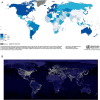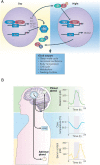The Pathophysiologic Role of Disrupted Circadian and Neuroendocrine Rhythms in Breast Carcinogenesis
- PMID: 27712099
- PMCID: PMC5045494
- DOI: 10.1210/er.2015-1133
The Pathophysiologic Role of Disrupted Circadian and Neuroendocrine Rhythms in Breast Carcinogenesis
Abstract
Most physiological processes in the brain and body exhibit daily (circadian) rhythms coordinated by an endogenous master clock located in the suprachiasmatic nucleus of the hypothalamus that are essential for normal health and functioning. Exposure to sunlight during the day and darkness at night optimally entrains biological rhythms to promote homeostasis and human health. Unfortunately, a major consequence of the modern lifestyle is increased exposure to sun-free environments during the day and artificial lighting at night. Additionally, behavioral disruptions to circadian rhythms (ie, repeated transmeridian flights, night or rotating shift work, or sleep disturbances) have a profound influence on health and have been linked to a number of pathological conditions, including endocrine-dependent cancers. Specifically, night shift work has been identified as a significant risk factor for breast cancer in industrialized countries. Several mechanisms have been proposed by which shift work-induced circadian disruptions promote cancer. In this review, we examine the importance of the brain-body link through which circadian disruptions contribute to endocrine-dependent diseases, including breast carcinogenesis, by negatively impacting neuroendocrine and neuroimmune cells, and we consider preventive measures directed at maximizing circadian health.
Figures





References
-
- Parkin DM, Bray F, Ferlay J, Pisani P. Global cancer statistics, 2002. CA Cancer J Clin. 2005;55:74–108. - PubMed
-
- Parkin DM, Fernández LM. Use of statistics to assess the global burden of breast cancer. Breast J. 2006;12(suppl 1):S70–S80. - PubMed
-
- Gery S, Komatsu N, Baldjyan L, Yu A, Koo D, Koeffler HP. The circadian gene per1 plays an important role in cell growth and DNA damage control in human cancer cells. Mol Cell. 2006;22:375–382. - PubMed
-
- Parkin DM. International variation. Oncogene. 2004;23:6329–6340. - PubMed
-
- Chia KS, Reilly M, Tan CS, et al. Profound changes in breast cancer incidence may reflect changes into a Westernized lifestyle: a comparative population-based study in Singapore and Sweden. Int J Cancer. 2005;113:302–306. - PubMed
Publication types
MeSH terms
Grants and funding
LinkOut - more resources
Full Text Sources
Other Literature Sources
Medical

